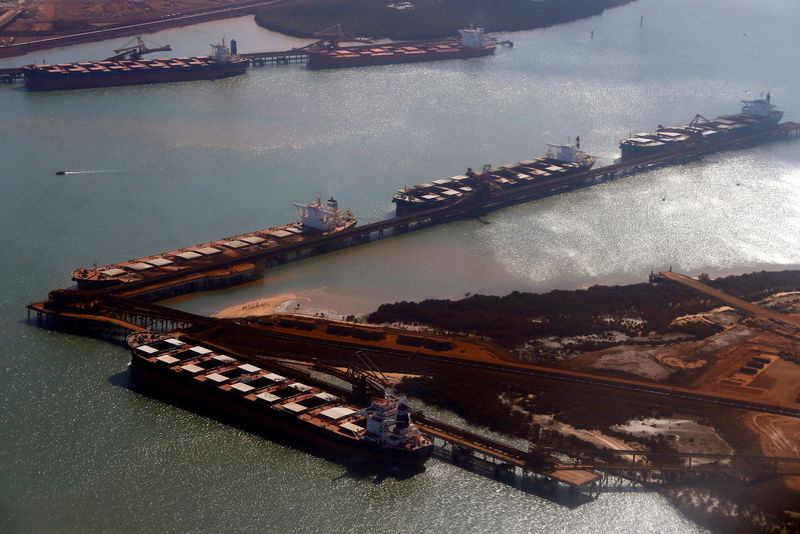By Wayne Cole
SYDNEY (Reuters) - Australia's export earnings are booming as resource prices surge but a statistical quirk means tens of billions of dollars go missing from main measures of growth, making the economy seem weaker than it actually is.
The cash is still coursing through the country - boosting profits, dividends, share prices and tax receipts. It's just written off as "inflation" and stripped from the real measures of gross domestic product (GDP) that dominate media coverage.
This is standard practice worldwide and usually makes perfect sense. After all, if GDP rose 10 percent but only because prices rose by 10 percent, then most people would be no better off.
But in Australia's case it is foreign buyers that pay the higher prices, not locals, while domestic inflation has slowed to its lowest pace in two years.
"It is unusual, but then Australia is unique in the breadth of commodities it exports, most of which have been rising in price," explained Bruce Hockman, chief economist at the Australian Bureau of Statistics.
Iron ore alone climbed almost 13 percent in the March quarter and 25 percent on a year earlier. In all, export prices were up 15 percent in the year to March and gifted the country its largest-ever trade surplus.
Yet the extra export dollars earned are still classed as inflation and removed by the statistician to make "real" GDP.
And it's a lot of cash. In nominal, or current dollars, exports boomed to a record A$438 billion last year, but take away price changes and real exports were only A$397 billion.
GRAPHIC: Divergence between nominal and real GDP - https://tmsnrt.rs/2DYlvfu
The A$41 billion "lost" was worth a huge 2.1 percent of nominal GDP. In the December quarter alone nominal exports added 0.8 percentage points to growth, but expressed in real terms they actually subtracted 0.1 percentage points.
That was a major reason growth disappointed so badly in the quarter by rising just 0.2 percent. That in turn has piled pressure on the Reserve Bank of Australia (RBA) to gin up the economy with cuts in interest rates.
FLUSH WITH CASH
The divergence is only getting larger as surging iron ore prices lifted exports to all-time highs in the March quarter.
The trade surplus of A$14.7 billion was easily the largest on record and might even have gifted Australia its first current account surplus in four decades.
While much of that bonanza will be lost from headline GDP, the dollars are not imaginary.
Just ask the miners who saw pre-tax profits climb 27 percent in 2018, driving up stock values and dividends. Shares in Fortescue Metals Group Ltd jumped almost 70 percent in the first quarter, while BHP rose 12 percent and Rio Tinto (LON:RIO) 25 percent.
Australia's main share index has risen A$200 billion in value so far this year and companies will be paying more than $29 billion in dividends from February to June.
Flush with cash, some miners are investing again after years of cutbacks, a shift highlighted by the RBA when it skipped a chance to cut interest rates this month. Leading the pack was Fortescue, which recently gave the go-ahead for a $2.6 billion iron ore project in Western Australia.
The lift in profits in turn boosted tax receipts, allowing both the ruling liberal National parties and the opposition Labor Party to offer generous tax cuts ahead of a federal election on May 18.
"The rest of the world is paying Australia a lot more for its exports," said Andrew Hanlan, a senior economist at Westpac.
"The government has the flexibility to cut income tax and boost spending, thereby providing some support to the household sector."
GRAPHIC: Nominal exports far outpaces real exports - https://tmsnrt.rs/2VTsXT7
LIVING IN THE NOMINAL WORLD
All those disappeared dollars do show up in nominal measures of GDP and income, but are routinely overlooked by markets.
That's a shame as annual growth in nominal GDP accelerated to a brisk 5.5 percent in the December quarter, far above the real 2.3 percent. The extra growth for 2018 as a whole was worth A$2,320 for every man, woman and child in the nation.
If this pickup was merely due to faster inflation it could be written off, but it's not. Inflation slowed to a sluggish 1.8 percent at the end of 2018 and braked sharply to a two-year low of 1.3 percent in the March quarter.
In the past, when nominal growth sped ahead like this the real measure tended to follow - albeit with a lag - offering hope the current soft patch is just temporary.
"Australia is one of very few developed countries where nominal and real GDP can go in wildly different directions and it's all because of commodities," said Michael Blythe, chief economist at Commonwealth Bank of Australia.

"Exports are driving a huge rise in national income that just doesn't show in real GDP," he added. "So right now, I would say the nominal numbers provide a better reading on the economy. After all, its the nominal economy that people really live in."